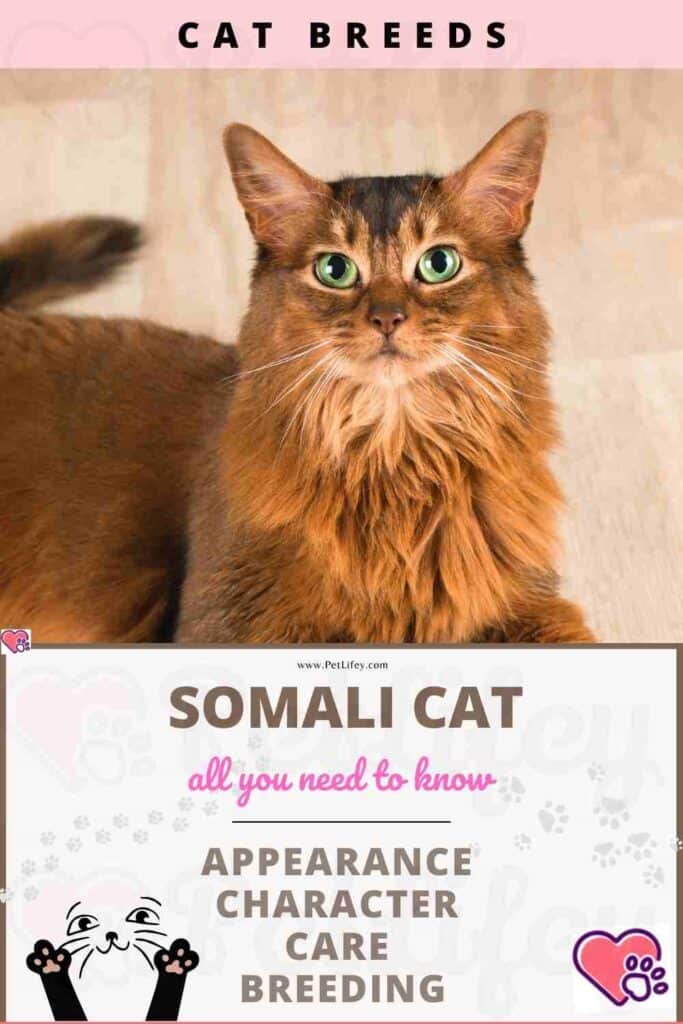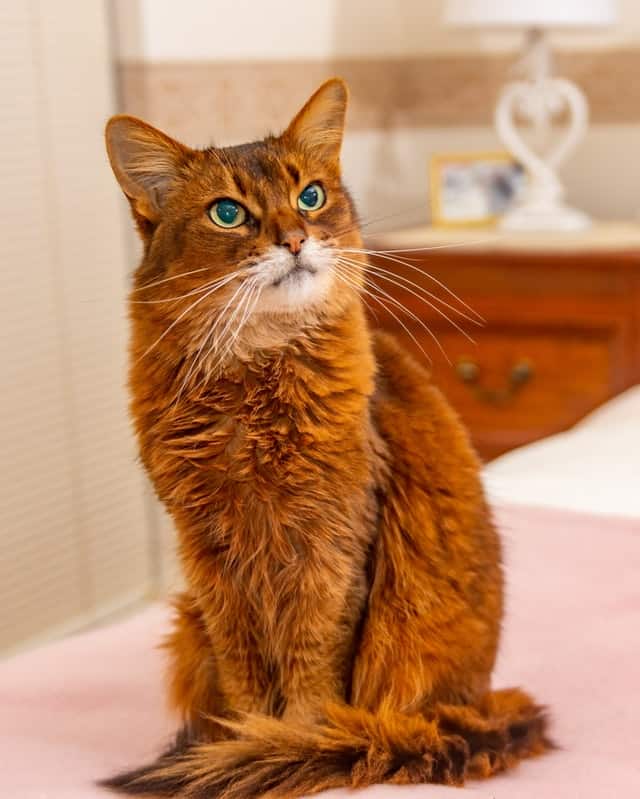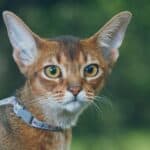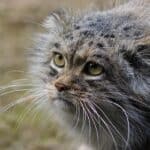
The Somali cat has a wild appearance and is incredibly beautiful and elegant; aware of its beauty, it likes to be watched and combed its fringed tail.
This cat has a particular character: looking for caresses, it shows its affection only when it is sure of the confidence and respect of its master; it’s ideal for people looking for a cheerful, lively, cuddly, yet fundamentally independent companion.
The origins of the Somali Cat

The Somali cat is nothing but a long-haired Abyssinian. Its place of origin is England where, a century ago, it was born from the crossing of an Abyssinian with a long-haired cat.
The recessive “long-haired” gene appeared, not in the first generation, but in the next; the fact did not attract the attention of breeders and was forgotten.
In the forties were born “erroneous Abyssinians”: mother nature had jealously preserved the recessive gene to present it again and to make fun of man, but it was not until the end of the seventies that a few enthusiasts. decided to select this new variety, calling it Somali.
The first to recognize this breed were the Americans. In a short time, these cats were appreciated and valued including in Australia and New Zealand. In 1977, a German breeder imported from the United States a copy of the Somali breed, which was very popular in Europe.
In the space of ten years, the Somali was recognized worldwide by the majority of feline associations which included it in the group of half-long haired cats.
Appearance of the Somali Cat
Its body structure makes the Somali cat a muscular, agile and graceful cat. Its body, of medium length, has a robust and well-developed musculature. The head is rounded, without flat edges.
The blunt muzzle has fairly full cheeks and a rounded chin. The ears, placed as if the cat were always on the lookout, are ample, slightly pointed, tilted forward and covered with a short, grippy hair.
The eyes, large and expressive, are almond shaped and gold, copper, green or hazelnut in color. Each eye is highlighted by the dark skin of the eyelid surrounded by a lighter area. Their colors are dark amber, yellow or green.
The thorax is rounded and the back slightly arched; the legs are slender and long, with small oval feet. The tail, long and broad at the base, gradually tapers towards the tip. The coat has a mid-length coat (on the shoulders it can be a little shorter), thick and soft.
Coat color of the Somali Cat
The coat of the Somali cat has the same ticking as the hair of the Abyssinian: two or three bands of color on each hair, the end of which is preferably dark.
Likewise, for the overall color, the tonality of the Abyssinian and the shaded, silver and chinchilla colors are admitted.
The hare color (inherited precisely from the Abyssinian) provides a tone ranging from apricot to dark terracotta, tending to red, barred with black; on the chest and inside the legs the color is slightly lighter.
Around the nose and the lips, on the chin and the throat, we admit the whitish tint; the toes are black or dark brown, with black between the toes, while the nose is brick red, edged with black and brown.
The chocolate varieties are actually forms diluted with sorrel and feature more reddish tones. Here the fingertips are pink with chocolate color between the fingers and the nose is pink too.
The blue-colored variety exhibits a warm, muted gray tone, blue fingertips with pinkish tones and a pink truffle. Lilac is a variation of blue that presents lighter and more delicate tones.
In fawns, the coat is a cool pinkish cream color, while the belly and the inside of the legs are pale cream. The fingertips and the nose are always pink. The hair takes its final color around the age of two only.
The character of the Somali Cat
The Somali cat has a very unique character: it is docile and affectionate but at the same time, independent and elusive. It is perfectly at ease with the man, whose caresses and compliments it seeks, but it is aware that it can survive without them, perhaps because of its formidable abilities as a hunter.
Because of its independent temperament, it tends to ignore the reproaches and prohibitions of its master, by whom it knows how to be “forgiven” with effusions as exuberant as they are unforeseen.
He tends to be close to only one family member, but it knows how to give affection to anyone who likes to play with them. When you cuddle them, you should know that caresses excite them: it is better to limit the duration of its effusions!
Endowed with an incredible physical resistance and an uncontrollable vivacity, it shows from an early age its champion soul: it would play whole hours without getting tired.
Its dream is to live in a house with a garden and trees, where it could ambush small prey and unleash its energy in crazy improvised races.
Forced to live in an apartment, it will be irritated by the lack of free space and will very often devote themselves to hunting rituals.
Hug:
Everyone is different, but in general they love a hug. Its confidence gained, it will be almost too affectionate.
Player: A
tireless player, it will remain so all its life. It will need heights and diversity to be happy.
Calm:
This feline is anything but calm. It likes to play too much!
Intelligent:
Very curious, it is interested in everything that is happening in its environment and wants to participate!
Fearful / Suspicious of Strangers:
If it needs time to get used to a new individual, the best way to gain its trust is without a doubt to play with them.
Independent:
Renowned independent, it will nevertheless be a very present member of its family.
Behavior of the Somali Cat
Talkative:
Discreet and melodious, Somali’s chatter, though sometimes pushy, is generally pleasant.
Gourmand / glutton:
This great player can also be a great eater. The interactive bowls will be able to satisfy its two great basic needs.
Need for exercise:
Although its appearance might suggest otherwise, it is a very active cat who needs to play every day.
Runaway:
Its curiosity can sometimes lead them to want to get away, while remaining loyal to its humans.
Compatibility of the Somali Cat with other animals
The Somali and the Dogs:
The Somali can develop a nice bond with a dog, provided they organize their presentations well. If it is not comfortable, however, it is important to respect them and offer them plenty of heights to allow them to be inaccessible, even if in the same room.
Somali and Other Cats:
With the right introduction, they may very well appreciate, or at least tolerate, the presence of another feline, even if they don’t feel the need to.
Somali and Children:
An active family with children may be a great fit for this feline, as long as the latter’s personality is comfortable with mini-humans!
The Somali and the Elderly:
Energetic like its short-haired cousin, it may be a little too rowdy in a quieter-than-average household.
Price of the Somali Cat
On average, the purchase price varies between 900 USD and 2500 USD, depending on the lineage, age, provenance, sex, etc. For the monthly budget, it will take an average of 50 USD / month to meet its needs, provide them with quality food and ensure its good health.
Maintenance of the Somali Cat
Grooming:
This cat requires almost daily brushing, with emphasis on the tail and the collar, but its non-woolly fur remains rather easy to maintain.
Hair loss:
He does not lose his hair in very large quantities, especially if his diet is of good quality.
Food for the Somali Cat
This cat’s caloric needs are a little higher than average, due to its higher than average activity level. But you shouldn’t overdo it to avoid being overweight.
Health of the Somali Cat
Life expectancy:
It lives on average 13 to 15 years.
Resistant / Robust:
It is generally a fairly robust cat.
Tendency to
gain weight : It will be necessary to ensure that the Somali remains active to avoid excess weight.
Frequent illnesses:
Generally in good health, it can still present the same pathologies as all other cats. It also has a certain fragility to periodontal disease (gingivitis and tartar). Prevention and dental care will be recommended. It can obviously present the same genetic diseases as its counterpart, namely:
The deficiency in pyruvate kinase, which causes anemia (a genetic test available)
The Atrophy Progressive Retinal, resulting in blindness (a genetic test is available)
The Amyloidosis , which leads to irreversible renal failure following the deposit of amyloid substance in the body. (No genetic test for the moment but the caution and vigilance of the breeders have nevertheless reduced the disease).
Breeding:
The Somali can be bred with an Abyssinian, since it is essentially a descendant of the latter. The kittens resulting from this cross may be long-haired, in which case they will be recognized as Somalis. They can also be born short-haired and in this case, these cats will be recognized as Abyssinians carrying the “long-haired” gene.
Good to know
The variable distribution of pigments on the coat gives each coat color an equally variable degree of softness.






